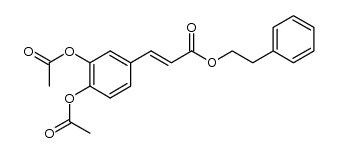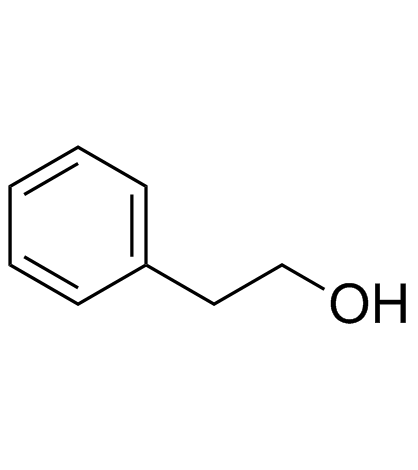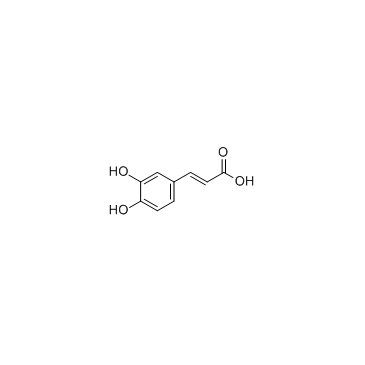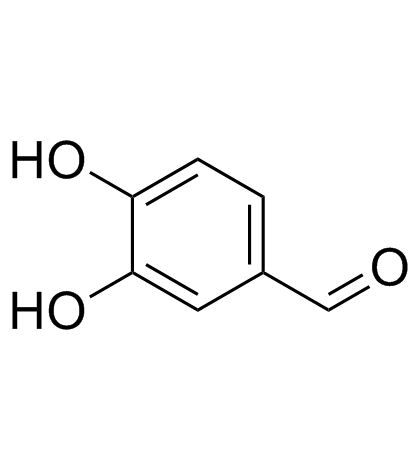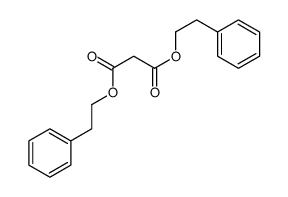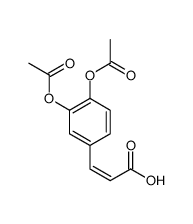Caffeic acid phenethyl ester
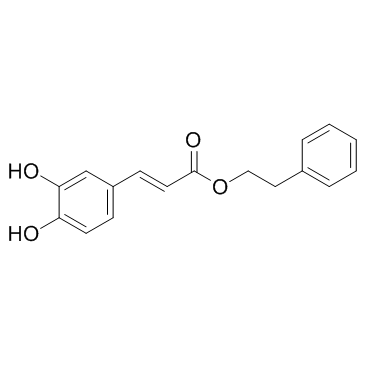
Caffeic acid phenethyl ester structure
|
Common Name | Caffeic acid phenethyl ester | ||
|---|---|---|---|---|
| CAS Number | 104594-70-9 | Molecular Weight | 284.306 | |
| Density | 1.3±0.1 g/cm3 | Boiling Point | 498.6±45.0 °C at 760 mmHg | |
| Molecular Formula | C17H16O4 | Melting Point | 129 °C | |
| MSDS | USA | Flash Point | 185.1±22.2 °C | |
Use of Caffeic acid phenethyl esterCaffeic acid phenethyl ester is a NF-κB inhibitor. |
| Name | phenethyl caffeate |
|---|---|
| Synonym | More Synonyms |
| Description | Caffeic acid phenethyl ester is a NF-κB inhibitor. |
|---|---|
| Related Catalog | |
| Target |
NF-κB |
| In Vitro | Caffeic acid phenethyl ester is a NF-κB inhibitor. Cell survival and proliferation of CRPC cell lines are all significantly suppressed by Caffeic acid phenethyl ester (CAPE) treatment dose-dependently. The growth inhibitory effect of Caffeic acid phenethyl ester is evident within 24 hours of treatment but the suppressive effect accumulates over time. The IC50 of 24, 48, 72, and 96 h Caffeic acid phenethyl ester treatment on LNCaP 104-R1 cells is 64.0, 30.5, 20.5, and 18.0 μM, respectively. Colony formation assay reveals that treatment with 10 μM Caffeic acid phenethyl ester reduces colony formation of LNCaP 104-R1 cells by 90% while treatment with 20 μM Caffeic acid phenethyl ester completely blocks the formation of LNCaP 104-R1 colonies. Flow cytometric analysis reveals a reduction of cells in the S phase and G2/M phase but an increase of cells in the G1 phase population in LNCaP 104-R1 cells under Caffeic acid phenethyl ester treatment. Caffeic acid phenethyl ester treatment also significantly decreases protein levels of fatty acid synthase (FAS), retinoblastoma protein (Rb), phospho-Rb Ser807/811, c-Myc, p70S6kinase, phospho-p70S6kinase Thr421/Ser424, Skp2, p90RSK, and NF-κB p65[1]. |
| In Vivo | Administration of Caffeic acid phenethyl ester (CAPE) by gavage (10 mg/kg body weight per day) for eight weeks results in 50% reduction of tumor volume, suggesting that Caffeic acid phenethyl ester treatment retards the growth of LNCaP 104-R1 xenografts. Caffeic acid phenethyl ester gavage slows down the tumor growth of LNCaP 104-R1 cells, which is consistent with our observation that Caffeic acid phenethyl ester treatment induces cell cycle arrest but not apoptosis[1]. |
| Kinase Assay | LNCaP 104-R1 cells are treated with 0, 10, 20, or 40 μM Caffeic acid phenethyl ester (CAPE) for 96 h. Three biological replicates of cells are lysed in SDS lysis buffer (240 mM Tris-acetate, 1% SDS, 1% glycerol, 5 mM EDTA pH 8.0) with DTT, protease inhibitors, and a cocktail of phosphatase inhibitors. Micro-Western Arrays are performed to measure protein expression and phosphorylation status modification[1]. |
| Cell Assay | LNCaP 104-R1 cells are seeded at a density of 3×103 cells per well in a 96-well plate. After 24 h, the cells are treated with increasing concentrations of Caffeic acid phenethyl ester (CAPE) for 96 h. Cell viability is assessed by an MTT (3,4,5-dimethylthiazol-2-yl)-2–5-diphenyltetrazolium bromide) assay. The amount of formazan is determined by measuring the absorbance at 560 nm using a plate reader. All results are normalized to the average of the control condition in each individual experiment. All experiments are repeated three times. Each time ten wells are utilized for each condition. The mean and standard deviation represent the results from all 30 wells in the three experiments[1]. |
| Animal Admin | Male Balb/c nu/nu mice at age 6 to 8 weeks of age are injected subcutaneously in both flanks with 5×105 LNCaP 104-R1 cells suspended in 0.5 mL of Matrigel and are injected subcutaneously into athymic mice to form tumors. After 14 weeks, the average tumor volume exceeds 150 mm3. The mice are then separated into control group and Caffeic acid phenethyl ester (CAPE) treatment group. Control group contains 6 mice and 8 tumors, while Caffeic acid phenethyl ester treatment group contains 6 mice and 9 tumors. Caffeic acid phenethyl ester (10 mg/kg/day in sesame oil) or vehicle (sesame oil) is administered by gavage starting from 14th week after cancer cell injection. Tumor volume and body weight of mice carrying 104-R1 xenografts are measured weekly using calipers and volume is calculated using the formula volume=length×width×height×0.52[1]. |
| References |
| Density | 1.3±0.1 g/cm3 |
|---|---|
| Boiling Point | 498.6±45.0 °C at 760 mmHg |
| Melting Point | 129 °C |
| Molecular Formula | C17H16O4 |
| Molecular Weight | 284.306 |
| Flash Point | 185.1±22.2 °C |
| Exact Mass | 284.104858 |
| PSA | 66.76000 |
| LogP | 3.38 |
| Vapour Pressure | 0.0±1.3 mmHg at 25°C |
| Index of Refraction | 1.646 |
| Storage condition | Store at 0°C |
|
Phenethyl Caffeate
Revision number: 5.3
SAFETY DATA SHEET Section1. IDENTIFICATION Product name:Phenethyl Caffeate Revision number:5.3 Section2. HAZARDS IDENTIFICATION GHS classification PHYSICAL HAZARDSNot classified HEALTH HAZARDS Skin corrosion/irritationCategory 2 Category 2A Serious eye damage/eye irritation ENVIRONMENTAL HAZARDSNot classified GHS label elements, including precautionary statements Pictograms or hazard symbols Signal wordWarning Hazard statementsCauses skin irritation Causes serious eye irritation Precautionary statements: Wash hands thoroughly after handling. [Prevention] Wear protective gloves/eye protection/face protection. IF IN EYES: Rinse cautiously with water for several minutes. Remove contact lenses, [Response] if present and easy to do. Continue rinsing. If eye irritation persists: Get medical advice/attention. IF ON SKIN: Gently wash with plenty of soap and water. If skin irritation occurs: Get medical advice/attention. Take off contaminated clothing and wash before reuse. Section3. COMPOSITION/INFORMATION ON INGREDIENTS Substance/mixture:Substance Components:Phenethyl Caffeate Percent:>98.0%(HPLC) CAS Number:104594-70-9 Synonyms:Caffeic Acid Phenethyl Ester , Phenethyl 3,4-Dihydroxycinnamate , 3,4- Dihydroxycinnamic Acid Phenethyl Ester , CAPE Chemical Formula:C17H16O4 Phenethyl Caffeate Section4. FIRST AID MEASURES Inhalation:Remove victim to fresh air and keep at rest in a position comfortable for breathing. Get medical advice/attention if you feel unwell. Skin contact:Remove/Take off immediately all contaminated clothing. Gently wash with plenty of soap and water. If skin irritation or rash occurs: Get medical advice/attention. Eye contact:Rinse cautiously with water for several minutes. Remove contact lenses, if present and easy to do. Continue rinsing. If eye irritation persists: Get medical advice/attention. Ingestion:Get medical advice/attention if you feel unwell. Rinse mouth. A rescuer should wear personal protective equipment, such as rubber gloves and air- Protection of first-aiders: tight goggles. Section5. FIRE-FIGHTING MEASURES Suitable extinguishingDry chemical, foam, water spray, carbon dioxide. media: Precautions for firefighters: Fire-extinguishing work is done from the windward and the suitable fire-extinguishing method according to the surrounding situation is used. Uninvolved persons should evacuate to a safe place. In case of fire in the surroundings: Remove movable containers if safe to do so. Special protectiveWhen extinguishing fire, be sure to wear personal protective equipment. equipment for firefighters: Section6. ACCIDENTAL RELEASE MEASURES Personal precautions,Use personal protective equipment. Keep people away from and upwind of spill/leak. protective equipment and Entry to non-involved personnel should be controlled around the leakage area by emergency procedures: roping off, etc. Environmental precautions: Prevent product from entering drains. Methods and materials for Sweep dust to collect it into an airtight container, taking care not to disperse it. containment and cleaning Adhered or collected material should be promptly disposed of, in accordance with up: appropriate laws and regulations. Section7. HANDLING AND STORAGE Precautions for safe handling Technical measures:Handling is performed in a well ventilated place. Wear suitable protective equipment. Prevent dispersion of dust. Wash hands and face thoroughly after handling. Use a local exhaust if dust or aerosol will be generated. Advice on safe handling: Avoid contact with skin, eyes and clothing. Conditions for safe storage, including any incompatibilities Storage conditions:Keep container tightly closed. Store in a freezer. Store away from incompatible materials such as oxidizing agents. Heat-sensitive Packaging material:Comply with laws. Section8. EXPOSURE CONTROLS / PERSONAL PROTECTION Install a closed system or local exhaust as possible so that workers should not be Engineering controls: exposed directly. Also install safety shower and eye bath. Personal protective equipment Respiratory protection: Dust respirator. Follow local and national regulations. Protective gloves. Hand protection: Eye protection:Safety glasses. A face-shield, if the situation requires. Skin and body protection: Protective clothing. Protective boots, if the situation requires. Section9. PHYSICAL AND CHEMICAL PROPERTIES Physical state (20°C):Solid Form:Crystal- Powder White - Pale yellow Colour: Phenethyl Caffeate Section9. PHYSICAL AND CHEMICAL PROPERTIES Odour:No data available pH: No data available Melting point/freezing point:129°C Boiling point/range:No data available Flash point:No data available Flammability or explosive limits: Lower:No data available Upper:No data available Relative density:No data available Solubility(ies): [Water]No data available [Other solvents]No data available Section10. STABILITY AND REACTIVITY Chemical stability:Stable under proper conditions. Possibility of hazardous No special reactivity has been reported. reactions: Incompatible materials: Oxidizing agents Hazardous decomposition Carbon monoxide, Carbon dioxide products: Section11. TOXICOLOGICAL INFORMATION Acute Toxicity:No data available Skin corrosion/irritation: No data available Serious eyeNo data available damage/irritation: Germ cell mutagenicity: dni-hmn-hla 5 umol/L dnd-hmn-lym 0.5 umol/L/18H Carcinogenicity: IARC =No data available NTP =No data available Reproductive toxicity:No data available RTECS Number:UD3334375 Section12. ECOLOGICAL INFORMATION Ecotoxicity: No data available Fish: Crustacea:No data available No data available Algae: Persistence / degradability: No data available No data available Bioaccumulative potential(BCF): Mobility in soil Log Pow:No data available No data available Soil adsorption (Koc): Henry's LawNo data available constant(PaM3/mol): Section13. DISPOSAL CONSIDERATIONS Recycle to process, if possible. Consult your local regional authorities. You may be able to dissolve or mix material with a combustible solvent and burn in a chemical incinerator equipped with an afterburner and scrubber system. Observe all federal, state and local regulations when disposing of the substance. Section14. TRANSPORT INFORMATION Hazards Class:Does not correspond to the classification standard of the United Nations Phenethyl Caffeate Section14. TRANSPORT INFORMATION UN-No:Not listed Section15. REGULATORY INFORMATION Safe management ordinance of dangerous chemical product (State Council announces on January 26, 2002 and revised on February 16,2011): Safe use and production, the storage of a dangerous chemical, transport, loading and unloading were prescribed. SECTION 16 - ADDITIONAL INFORMATION N/A |
| Personal Protective Equipment | dust mask type N95 (US);Eyeshields;Gloves |
|---|---|
| Hazard Codes | Xi: Irritant; |
| Risk Phrases | R36/37/38 |
| Safety Phrases | S26-S36 |
| RIDADR | NONH for all modes of transport |
| RTECS | UD3334375 |
| HS Code | 2918290000 |
|
~74% 
Caffeic acid ph... CAS#:104594-70-9 |
| Literature: European Journal of Medicinal Chemistry, , vol. 75, p. 391 - 402 |
|
~61% 
Caffeic acid ph... CAS#:104594-70-9 |
| Literature: EP1211237 A1, ; Example 1 ; |
|
~84% 
Caffeic acid ph... CAS#:104594-70-9 |
| Literature: Journal of Chemical Research, , # 5 p. 332 - 334 |
|
~70% 
Caffeic acid ph... CAS#:104594-70-9 |
| Literature: Chemical and Pharmaceutical Bulletin, , vol. 49, # 2 p. 236 - 238 |
|
~% 
Caffeic acid ph... CAS#:104594-70-9 |
| Literature: Bioorganic and Medicinal Chemistry, , vol. 10, # 10 p. 3351 - 3359 |
|
~% 
Caffeic acid ph... CAS#:104594-70-9 |
| Literature: Bioorganic and Medicinal Chemistry, , vol. 10, # 10 p. 3351 - 3359 |
|
~% 
Caffeic acid ph... CAS#:104594-70-9 |
| Literature: Journal of Chemical Research, , # 9 p. 586 - 588 |
|
~% 
Caffeic acid ph... CAS#:104594-70-9 |
| Literature: Journal of Chemical Research, , # 5 p. 332 - 334 |
|
~% 
Caffeic acid ph... CAS#:104594-70-9 |
| Literature: European Journal of Medicinal Chemistry, , vol. 75, p. 391 - 402 |
| Precursor 9 | |
|---|---|
| DownStream 0 | |
| HS Code | 2918290000 |
|---|---|
| Summary | HS: 2918290000 other carboxylic acids with phenol function but without other oxygen function, their anhydrides, halides, peroxides, peroxyacids and their derivatives Tax rebate rate:9.0% Supervision conditions:AB(certificate of inspection for goods inward,certificate of inspection for goods outward) VAT:17.0% MFN tariff:6.5% General tariff:30.0% |
|
Ganglioside GM3 is required for caffeic acid phenethyl ester-induced megakaryocytic differentiation of human chronic myelogenous leukemia K562 cells.
Biochem. Cell Biol. 92(4) , 243-9, (2014) The human chronic myelogenous cell line K562 has been used extensively as a model for the study of leukemia differentiation. We show here that treatment of K562 cells with caffeic acid phenethyl ester... |
|
|
Inhibition of COX-2-mediated eicosanoid production plays a major role in the anti-inflammatory effects of the endocannabinoid N-docosahexaenoylethanolamine (DHEA) in macrophages.
Br. J. Pharmacol. 172(1) , 24-37, (2014) N-docosahexaenoylethanolamine (DHEA) is the ethanolamine conjugate of the long-chain polyunsaturated n-3 fatty acid docosahexaenoic (DHA; 22: 6n-3). Its concentration in animal tissues and human plasm... |
|
|
Effects of caffeic acid phenethyl ester on wound healing in calvarial defects.
Acta Odontol. Scand. 73(1) , 21-7, (2014) The aim of this study is to analyze histologically the effect of CAPE on bone healing of Critical Size Defect (CSD) in rat calvaria.Thirty-two 3-month-old male rats were used. The animals were randoml... |
| Phenethyl 3-(3,4-dihydroxyphenyl)acrylate |
| Phenylethyl caffeate |
| Phenethyl caffeate |
| 2-Phenyethyl caffeate |
| 2-Phenylethyl (2E)-3-(3,4-dihydroxyphenyl)acrylate |
| CAPE |
| 2-Propenoic acid, 3-(3,4-dihydroxyphenyl)-, 2-phenylethyl ester, (E)- |
| Phenethyl 3,4-Dihydroxycinnamate |
| MFCD00866470 |
| 2-phenylethyl (2E)-3-(3,4-dihydroxyphenyl)prop-2-enoate |
| Caffeic acid phenethyl ester |
| 3,4-Dihydroxycinnamic Acid Phenethyl Ester |
| Caffeic acid 2-phenylethyl ester |
| Caffeic Acid phenylethyl ester |
| 2-Phenylethyl caffeate |
| 2-Phenylethyl caffeoate |
| 2-Propenoic acid, 3-(3,4-dihydroxyphenyl)-, 2-phenylethyl ester, (2E)- |
